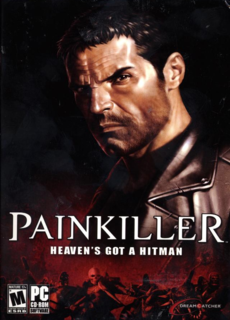Loud, fast-paced, and creepy: my favorite recipe for a nice "twitch" shooter...
Although I’m easily impressed by shiny objects and majestic vistas, twenty-five levels of run-and-gun mayhem won’t amount to squat if the gameplay isn’t right, but I’m pleased to say that Painkiller scored incredibly high marks in that area, as well. Every dual-purpose weapon was a joy to use in its own way: whether lobbing some grenades at the feet of a large crowd of roaring corpses and then pinning those that remain to the nearest wall or, my favorite, flash-freezing a rampaging demon and then shattering the crystalline statue that remains, I suspect that most players will try a little bit of everything in their arsenal, particularly on the harder levels when ammo is at more of a premium.
The folks at People Can Fly smartly recognized that barreling into one crowd of revenants after another can grow boring no matter how many methods of destruction are provided, so they added a little something that really appealed to my inner-OCD: magic Tarot cards. Much like my love for receiving rewards for being a good boy, I appreciate the gift of several seconds of bullet-time for having nabbed a certain number (or none at all) of the phantasmal puffs of ectoplasm left behind by every fallen foe. I obediently refrained from using grenades and rockets on certain levels or exclusively kept the spinning blades of my Painkiller toy unholstered to earn skills that ranged from indescribably useful (like damage enhancers or the aforementioned slo-mo powerup) to quirky and/or totally optional (like the Confusion modifier that sparks an all-out brawl among enemies). I can’t accurately recall how many times I tried bunny-hopping across a deadly canal for a sparkly chalice or scurried around fetching spilt currency in the midst of battle to keep my collection of active and passive powers in constant rotation.
Out of all of the game’s positives, Painkiller’s most notable dark spot is found in all of that doggone leaping and skipping for prizes that I mentioned earlier. However, even that point of frustration was mitigated greatly once I learned how to exploit the subtle curvature of a wall or a block of debris when scampering up to seemingly unreachable niches and shelves. Still, I was certain that I would wear out my right mouse button by the time I reached the tragic tableaus of the astonishingly cool final level. I heartily recommend this title for anyone who enjoys heart-slamming pitched battles that leave them with a handful of hit points and a taste for even more corrupted blood.

